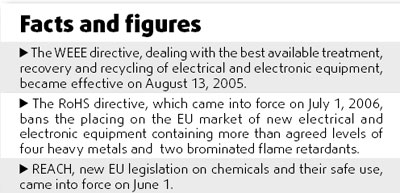Getting in sync with green directives
There has been a raft of "green directives" from the European Union in recent years.
After the Restriction of Hazardous Substances (RoHS) banning specific substances, the Waste Electrical and Electronic Equipment directive (WEEE), and the regulatory framework for Registration, Evaluation, Authorization and Restriction of Chemicals (REACH), the latest is a "green directive" on energy-using products (EuP), which affects all links in the industry chain - from design, manufacturing and transport to disposal.

Since its first one in 1973, the European Union has drawn up six similar environment action plans under which it has built up a legal system concerning the environment. Experts say such regulations follow the increasing global concerns about environmental protection.
Zhao Yumin, an analyst from the trade and economic cooperation institute with the Ministry of Commerce, said that apart from environmental protection, the EU expects to gain a bigger say in setting up international standards with such regulations.
Besides the European economic bloc, which is seen as the most concerned with environmental protection, the United States, Japan and Brazil also recently reported to the World Trade Organization new and amended regulations on environmentally friendly and energy-saving electronic products.
Zhao said such regulations on product quality and safety, which some describe as "green barriers", are being increasingly used in international trade as countries apply fewer traditional trade barriers such as tariffs.
A number of countries worry the various standards not only increase costs of enterprises but also distort free trade.
The MOFCOM said it will closely monitor the EuP framework, which took effect last month.
"In case items violating WTO rules are found, China will get in touch with the European side to eliminate barriers for Chinese products," said an official from the bureau of fair trade under the MOFCOM who declined to be named.
The EuP directive, which is still a framework, is expected to deeply affect Chinese exporters, especially those in the business of energy-using products such as electrical motors, lighting, household appliances, office equipment and consumer electronics, including personal computers, to the EU. A source with the EU said 80 percent of the products that will be hit by the EuP are from China.
The directive will have "a direct impact on companies involved in the machinery and electronics industries, and related chemical and metallurgical firms", said an official who also didn't want to be named.
In the short term, the directive will increase companies' outlay for product development and consumption testing, he said. "In the medium and long term, however, firms can lower costs by optimizing design and materials in the manufacturing process and reducing disposal costs as environmental impact will be factored into their strategies," he said.
Companies "shouldn't see it as an increase in costs or view as a loss any decline in exports as a result of the directive", he said, but suggested firms exporting certain products to the EU prepare for the change.
As has happened with other EU environmental legislation, the directive has the potential to be adopted by other developed countries, said Chen Yansheng from the China Association of Lighting Industry. Even developing countries are likely to follow suit, he added.
(China Daily 10/12/2007 page15)














